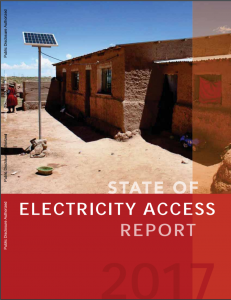Full Title: State of Electricity Access Report 2017
Author(s): The World Bank
Publisher(s):
Publication Date: May 1, 2017
Full Text: Download Resource
Description (excerpt):
The World Bank’s Energy Sector Management Assistance Program (ESMAP) Committed to delivering the “State of Electricity Access Report (SEAR)” project as part of the Sustainable Energy for All (SE4ALL) Knowledge Hub activities. The SEAR is intended to complement the Global Tracking Framework (GTF) Report Series, the work on the Multi-Tier Framework, and the recently launched Regulatory Indicators for Sustainable Energy by serving as a periodical stocktaking of the status and nature of progress on the target of ensuring universal access to affordable, reliable, modern energy services by 2030.
The SEAR 2017 begins with an examination of the critical role of electricity access toward the achievement of the SDG’s, the provides a snapshot of the status of electricity access based on the recent Global Tracking Framework Data (IEA and World Bank, 2017). It goes on to explore how countries can create a conducive environment for a transformative electricity access roll out, how clean energy fits into the picture, and how emerging and innovative service delivery models can accelerate progress on meeting the goals.
Its objective is to prompt governemnts, donors, the private sector, civil society organizations, and practitioners to develop interventions to close the electricity access gap by integrating lessons learned from countries that have expanded electricity access to their population, with insights drawn from emerging innovative business and delivery models.
The SEAR 2017 is articulated around five main questions.
- Why is electricity access critical for the achievement of the 2030 Agenda for Sustainable Development?
- What is the status of electricity access?
- What are the challenges and drivers of transformative electricity access?
- Why is it important to explore synergies between access, renewables, and energy efficiency?
- What are the emerging and innovative business and delivery models?
